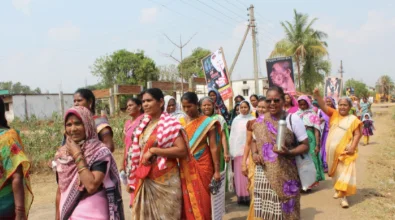Amhi Amchya Arogyasathi translates as “We for our health”, but the scope of this organisation’s work has been far more extensive in the 40 years since it was founded. Based in eastern Maharashtra’s Vidarbha region, AAA works closely with village and slum communities to promote not only health and nutrition, but also sustainable agriculture, sustainable livelihoods, gender equality, education and policy advocacy at the grassroots level. According to AAA’s mission statement, justice and equity are the foundational values on which all its programmes and projects are based.
In recent years, the organisation’s work has focused on training members of Panchayati Raj Institutions in planning and the use of health funds, as well as in monitoring health and nutrition services. It has also been mobilising and empowering rural and tribal women to form their own federations, so that they can address social and economic issues and proactively take them up with local government bodies.
Since the 1990s, AAA has successfully established 1,500 women’s self-help groups across Gadchiroli district. The SHGs work, among other things, to educate women about laws, monitor implementation of schemes and monitor the condition of girls in government ashram schools for tribals. So far, 350 of the SHGs have received loans worth Rs 1.35 crore from public banks for small businesses and agriculture.
The project supported by MFE:
Empowering Women and Strengthening Livelihood Through Local Self-Governance
This project, focusing on 20 villages in Gadchiroli’s Korchi block, aims to positively impact the economic lives of 1,233 families over three years.
Its main goal is to educate women about their rights in community-based organisations, so that they can participate in the planning and implementation of programmes that affect them. At the end of three years, AAA plans to have one fully-trained woman leader in each of the 20 villages, and bring about equal representation of women in 70% of the local CBOs. As of now, just 2% to 3% of the gram sabhas in these villages are organised by women; the project aims to increase this figure to 70%. It also aims to increase women’s knowledge of financial audits and key laws like the Forest Rights Act, the Panchayat Extension to Scheduled Areas Act and NREGA.
The project’s second goal is to increase women’s ownership and control over individual and common property rights. To this end, AAA has a target of getting 100 women ownership over Individual Forest Rights, and ensuring that 30% of the local women get their wages from non-timber forest produce directly into their own bank accounts, instead of the current figure of just 2%.
Finally, the project aims to create a gender-aware, sustainable livelihood system in the 20 target villages, which includes diversifying food consumption and increasing family incomes. It will introduce ecological farming to 540 families, covering 400 acres of land, and help 600 families set up backyard kitchens for seven months in a year. According to the project goals, 375 families are to see a 20% increase in income from non-timber forest produce, 210 families are to see a 40% rise in income from livestock, and another 60 families are to see a 20% increase in income from micro-enterprises.

